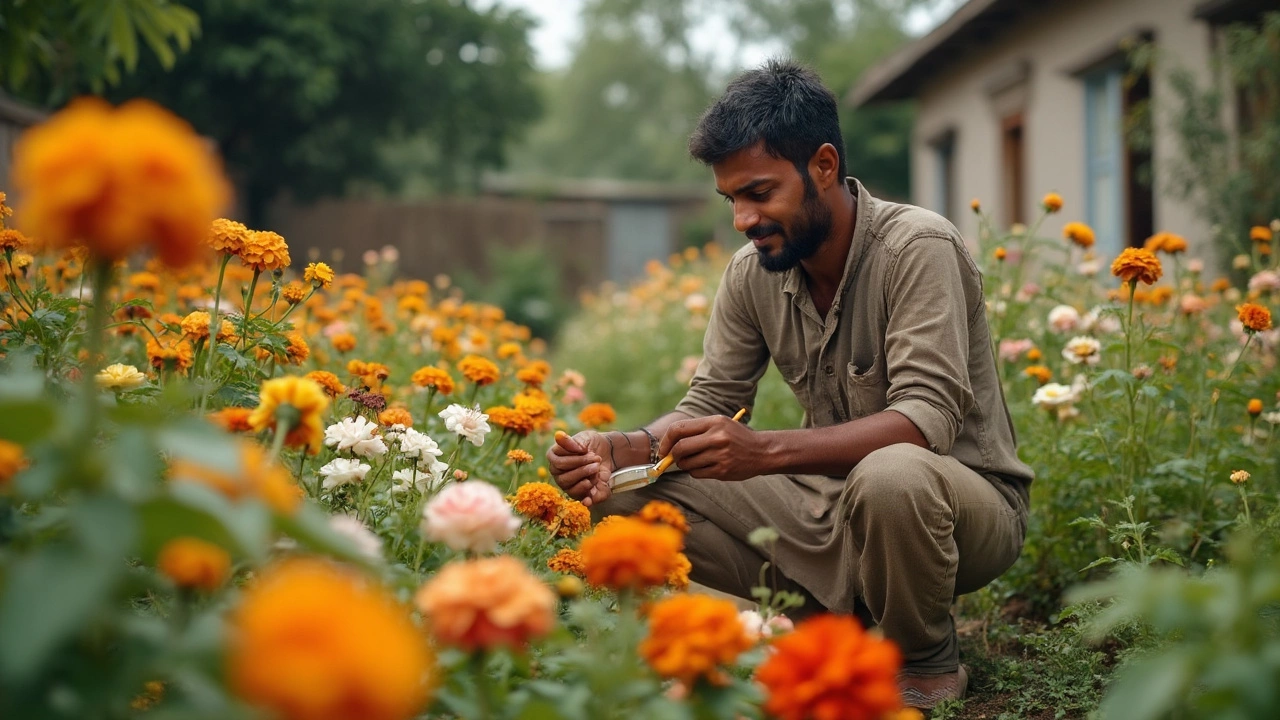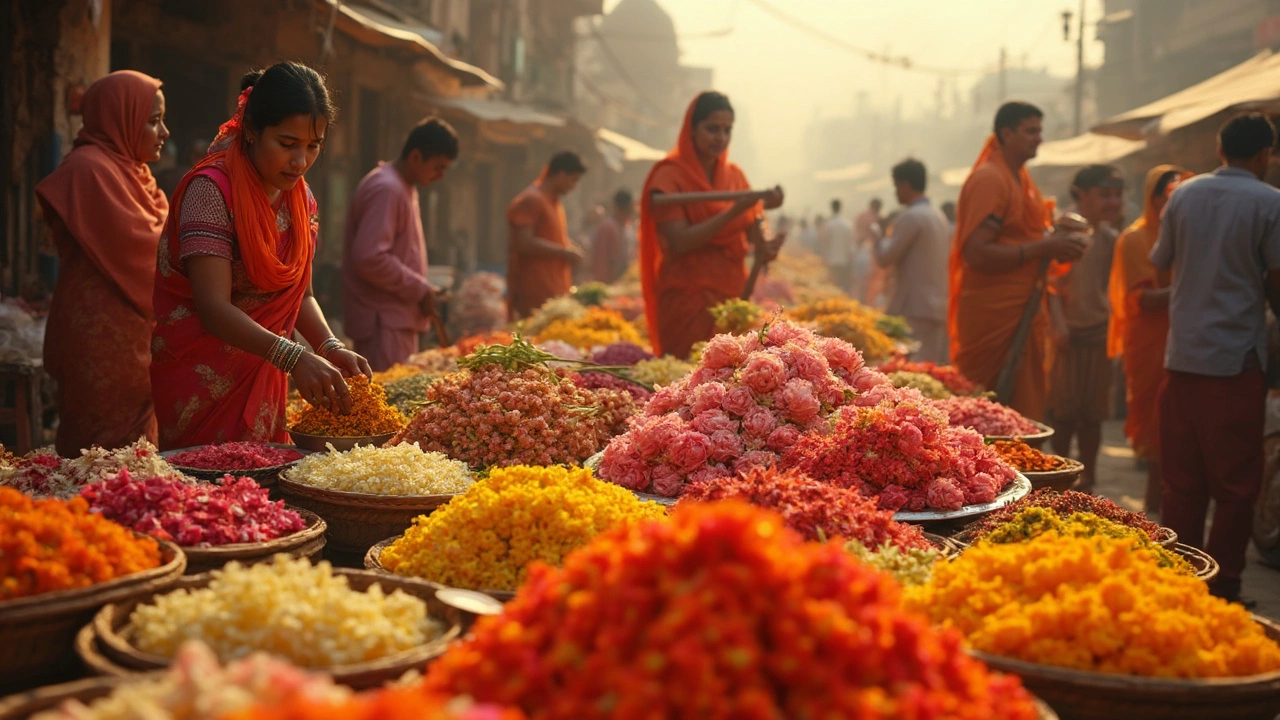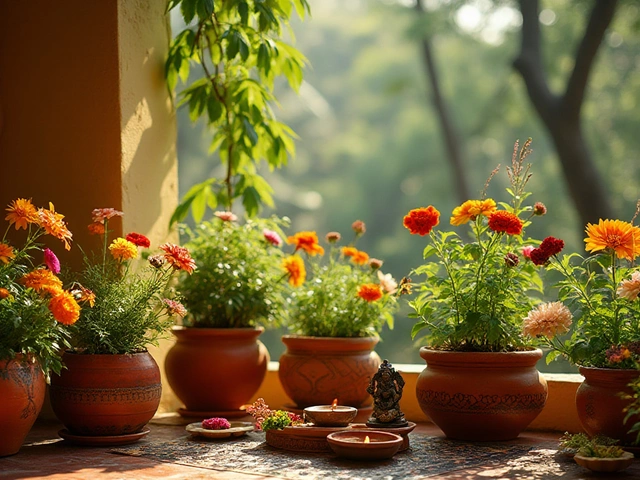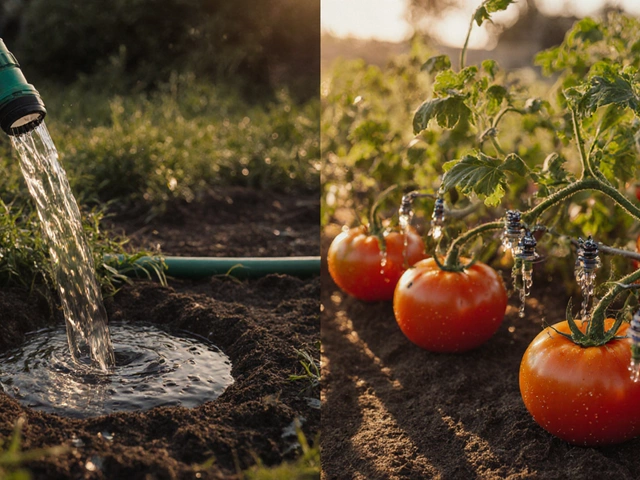Walk through any street in India during festival season, and you’ll spot the same flowers in every garland and decoration. Ever wonder what makes certain blooms just fly off the shelves, while others get ignored? If you’re hoping to grow flowers for fun or profit, it pays to know which ones deliver the best bang for your buck.
There’s no guessing here: marigold leads the pack like a rockstar, followed closely by roses, jasmine, and lotus. Whether it’s bustling temple rituals, massive wedding setups, or daily prayers, these flowers are in everyone’s shopping list. Prices for marigolds, for instance, spike ahead of Diwali and wedding season—sometimes doubling overnight because people just can’t do without them.
Lots of people wonder if it’s hard to grow these flowers at home or for sale. Actually, you don’t need fancy equipment—just the right info and a bit of consistency. Keep reading, and you’ll see which flowers drive India’s vibrant market, plus get down-to-earth tips to grow the most wanted blooms in your own patch.
- Flowers that Indians Just Can’t Get Enough Of
- Why Marigold Is the Go-To Blossom
- Roses: India’s Year-Round Favorite
- Jasmine and Lotus: Local Stars with Big Demand
- Tips for Growing High-Demand Flowers at Home
- Making the Most Profitable Choices as a Flower Seller
Flowers that Indians Just Can’t Get Enough Of
If you look at the busiest flower markets in India, you’ll notice a handful of superstar blooms always in short supply. These aren’t just random picks. Their demand is backed by real traditions, religious routines, and social events.
The flowers leading the flower demand India charts are:
- Marigold (Genda): Used in religious rituals, weddings, and even on vehicles for pooja. A single big city market like Dadar in Mumbai can shift over 100 tons of marigolds in one day before Diwali.
- Rose: The classic for gifting—roses are in demand year-round for everything from saying “I love you” to “I’m sorry.” Northern cities like Delhi and cities in Tamil Nadu run massive rose auctions every morning.
- Jasmine (Mogra): Top favorite for hair adornment, especially in the south. No South Indian wedding is complete without jasmine strings. They’re also a must for temple offerings.
- Lotus: The national flower, sacred for Hindu and Buddhist ceremonies. Lotus sees a spike before major festivals like Ganesh Chaturthi.
- Chrysanthemum: Its vibrant colors boost its popularity, especially for garlands and big arrangements during ceremonies.
- Tuberose (Rajnigandha): Popular for its unique scent, often used in high-end decorations and religious offerings.
Just how much are people buying? Take a look at this quick snapshot from a major flower marketplace during festival season:
| Flower | Festival Season Price (per kg/lot) | Daily Traded Quantity (approx.) |
|---|---|---|
| Marigold | ₹120–₹220 | 100–150 tons |
| Rose | ₹80–₹300 | 60–100 tons |
| Jasmine | ₹700–₹1200 | 20–30 tons |
What becomes obvious: if you’re thinking of growing or selling flowers in India, sticking with these big names makes sense. These are the flowers that truly fuel the popular Indian flowers and flower market trends you see everywhere, especially during peak times like weddings and religious festivals.
Why Marigold Is the Go-To Blossom
Ask anyone in India about the most popular flower, and marigold almost always comes up first. This bright yellow-orange bloom is everywhere—from weddings, temples, and poojas, to festivals like Diwali and Ganesh Chaturthi. It's not just because marigolds are pretty—they're actually super practical, hardy, and cheap to grow, making them the top pick in the flower demand India scene.
Marigolds survive in both hot and mild weather, which is a big win in a country where the summer sun can be brutal. Farmers love them because they only take about 45 to 50 days from planting to reach peak blooming. So you get flowers fast and can even plant them multiple times a year. That’s a solid business if you want to make extra cash selling flowers locally.
Here's the kicker—marigold prices can spike during big festivals and wedding months. Since they’re a must-have for rituals, demand typically shoots up by at least 60% during those times. The blooms are also used in piles of garlands and decorations, so florists go through heaps of them.
| Month | Avg. Marigold Price (per kg, INR) |
|---|---|
| January | 40 |
| April | 50 |
| October | 90 |
| November | 100+ |
Marigolds are simple to grow at home. All you need is a sunny spot and soil that drains well—skip the fancy fertilizers. Once they start, just pluck the dead flowers off, and you’ll keep getting new blooms. No wonder marigold tops the list for popular Indian flowers and gives a great return for anyone in the flower market trends.
- Plant marigold seeds in well-drained soil in a sunny area.
- Water regularly, but don’t overdo it—let the soil dry a bit between rounds.
- Pinch off wilted flowers to get more blooms.
- Don’t bother with expensive nutrients—marigold is low-maintenance.
If you need dependable flowers that always sell, you can’t go wrong with marigolds in India. Whether it’s for your home or as a money-maker, this flower is a top contender year after year.
Roses: India’s Year-Round Favorite
The rose isn’t just another pretty flower in India; it’s a business, a way to express emotions, and a must-have during any festival or Friday prayer. From big city markets in Delhi to small flower stalls in remote towns, roses never go out of demand. In fact, India is one of the world’s top producers of roses—especially in states like West Bengal, Maharashtra, and Karnataka, where the climate suits large-scale growing.
If you’re curious why roses do so well here, it's simple: they suit everything from wedding garlands to Mother’s Day bouquets. Indian temples often use red and yellow roses for rituals. Florists say that out of every five flower orders, at least three include roses, especially on holidays or during wedding season.
Here’s a quick look at where the demand comes from throughout the year:
| Occasion | Peak Rose Demand |
|---|---|
| Valentine’s Day | Extremely high |
| Weddings (Oct-Feb) | Very high |
| Festivals (like Holi, Diwali) | High |
| Daily Puja/Prayers | Steady |
If you’re thinking of growing them or getting into flower demand India as a business, go for varieties like Grand Gala, Taj Mahal, or Dutch Rose. These are popular with florists for their color and durability. Hybrid Tea roses fetch a good price because they last longer in bouquets.
Tips for growing healthy roses in Indian conditions:
- Pick a spot with at least six hours of sunlight.
- Use well-drained, fertile soil mixed with compost.
- Don’t overwater—roses hate waterlogged roots.
- Deadhead old blooms to encourage new flowers.
- Watch for pests like aphids and treat with neem oil if needed.
The rose market can be unpredictable—prices usually shoot up before major festivals or Valentine’s Day, so plan your harvest and sales to match those peaks. Selling roses isn’t just about growing them; it helps to connect with local florists or join farm cooperatives for better prices and stable buyers.

Jasmine and Lotus: Local Stars with Big Demand
Here’s something not everyone knows: after marigold and rose, jasmine and lotus are neck-and-neck for top spots in flower demand India, especially in the south. Walk into a Chennai market and you’ll see rows of women threading fresh jasmine into garlands, ready for everything—from morning prayers to weddings. In Karnataka and Tamil Nadu, jasmine is almost as common as breakfast tea. Demand peaks during festivals like Ugadi and Onam, and prices shoot up fast the moment supply drops.
Lotus, on the other hand, is a different story. It’s not just our national flower; it’s a staple at temples across North and Central India. You’ll spot heaps of pink and white lotus at big festivals, but they also hold a steady market thanks to year-round religious rituals. The thing is, lotus isn’t as easy to grow as jasmine. These plants need ponds or at least big containers filled with water. Slow-growing, yes, but when you do it right, the payoff is solid because demand stays high and the price rarely crashes.
Quick facts that might surprise you:
- Jasmine flowers are shipped every day from Madurai to export markets in the Middle East and Southeast Asia. Local growers earn a premium when summer demand spikes during wedding season.
- Lotus farming is bigger business than you think, sometimes fetching up to ₹12-15 per flower in religious hubs during festive months.
Want some actual numbers? Check out this snapshot of wholesale prices during peak festival time:
| Flower | Avg. Price per Kg (INR) | Peak Season |
|---|---|---|
| Jasmine | 400-600 | March–August |
| Lotus | 12-15 (per flower) | August–November |
If you’re thinking about growing either of these at home, jasmine is the less tricky of the two. Just grab some healthy cuttings and plant in a spot that gets plenty of sunshine. Keep the soil well-drained and water regularly, especially in the warmer months. For lotus, be ready for a little extra work—a big tub or mini pond, good sunlight, and regular mucking out to keep the water clean. But if you pull it off, you’ll have one of India’s most sought-after popular Indian flowers right at home.
Tips for Growing High-Demand Flowers at Home
If you’re new to flower gardening in India or simply want better results, growing high-demand flowers like marigold, rose, and jasmine is totally doable with the right hacks. No need for high-tech equipment—just get the basics right and you’ll soon be picking your own blooms for pujas or even selling them to neighbors.
- Marigold: These guys are the Indian home gardener’s best friend. They love sunlight, can handle most soils (though sandy loam is best), and don’t fuss much about water. Just sow seeds directly into the soil at the start of June (for the rainy season) or in December (for winter blooms). Deadhead old flowers to encourage new growth—seriously, just snip them off when dry.
- Roses: Pick a spot that gets at least 5 hours of sun daily. Use a mix of garden soil, compost, and a bit of sand to keep roots from drowning. Water every other day. Pruning is your pal—cut back long or dried stems after the main bloom flush around February to keep them bushy. A simple neem oil spray sorts out most pests.
- Jasmine: This one is perfect if you have a fence or balcony. Use well-drained soil and avoid letting water clog the pot. For best flowers, feed with basic cow dung manure every two months and just let nature do its thing. Prune after flowering so you get more shoots.
- Lotus: If you have a big pot or a small pond, lotus can be more straightforward than folks think. Use a wide and shallow tub, plant rhizomes in heavy clay-like soil, and make sure water is at least 10-12 inches deep. Change the water every few weeks to keep things clean.
Here’s a quick cheat sheet to plan your garden for the flower market trends in India:
| Flower | Best Sowing Time | Days to Bloom |
|---|---|---|
| Marigold | June or December | 45-60 days |
| Rose | September-February | 90-120 days |
| Jasmine | March-May | 120 days |
| Lotus | February-April | 90-120 days |
If you want to sell, focus on marigolds and roses—they’re staples for everything from weddings to religious events, so there’s always a steady demand. Start small, keep track of what’s blooming when, and talk to local flower vendors for insider info—they know what sells and when. Little things like regular deadheading and picking early in the morning can actually boost how long your popular Indian flowers stay fresh after cutting. Pretty practical, right?
Making the Most Profitable Choices as a Flower Seller
If you’re planning to get into the flower business in India, you want to zero in on the flower demand India pattern. What actually sells? Here’s the simple truth: marigold, rose, and jasmine almost guarantee buyers 365 days a year. That’s because these popular Indian flowers are the backbone of religious events, weddings, and daily rituals. Even small flower shops in tier-2 or tier-3 towns can’t go wrong with these options.
Marigolds, especially the bright yellow and orange types, fly off the shelves before festivals like Diwali and Ganesh Chaturthi. Roses are the go-to for Valentine’s Day, birthdays, and any event that needs a touch of class. Jasmine gets a daily boost from people buying it for temple offerings or to string into garlands at home. If you’re close to urban areas, you might also see extra demand for orchids or lilies during fancy events, but these need more care and investment.
| Flower | Main Buying Occasions | Average Price Per Kg (INR) | Demand Peak Months |
|---|---|---|---|
| Marigold | Festivals, weddings | 60–120 | Aug–Nov |
| Rose | Weddings, day-to-day, Valentine’s | 80–160 | All year, Feb spike |
| Jasmine | Rituals, garlands, daily home use | 250–400 | Apr–July, steady all year |
| Lotus | Special rituals, festivals | 10–20 per flower | July–Oct |
So, how do you make sure you’re not stuck with unsold blooms or poor rates? Timing and location matter. Plan to have marigolds ready just before major religious seasons, or roses in time for special days. If you’re growing flowers at home, even a 200-square-foot patch can give you extra income if you match your growing calendar with flower market trends.
- Use social media to advertise – it’s free and lots of customers buy flowers online for home delivery now.
- Try contract farming with local temples or event planners – they’ll often pay more for bulk and steady supply.
- Grow traditional varieties (local marigold, desi rose) over imported ones, since they last longer without cold storage.
- If you’re near a city, test orchids or lilies for high-margin sales during wedding season, but start small to avoid big losses.
It’s not about guessing; watch local festivals and customer habits. Keep your ear to the ground and you’ll know when to scale up or switch crops. Make data your friend—track your own sales and check market prices every few weeks for the most in demand flowers in your area. This way, you can focus your energy (and money) where the biggest payback lies.





